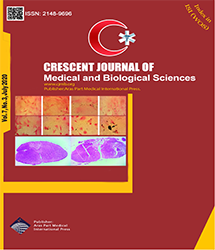| Original Article | |
| Collagen I Gel Increases the Osteogenic Potential of Platelet-Rich Plasma in Adipose-Derived Stem Cells | |
| Hossein Kalarestaghy1,2, Hajar Shafaei1,3, Raheleh Farahzadi4, Parviz Vahedi5, Mohamad Amin Dolathkhah3, Abbas Del Azar6, Nahid Karimian Fathi1 | |
| 1Stem Cell Research Centre, Tabriz University of Medical Sciences, Tabriz, Iran 2Research Laboratory for Embryology and Stem Cells, Department of Anatomical Sciences and Pathology, Faculty of Medicine, Ardabil University of Medical Sciences, Ardabil, Iran 3Department of Anatomical Sciences, Faculty of Medicine, Tabriz University of Medical Sciences, Tabriz, Iran 4Hematology and Oncology Research Center, Tabriz University of Medical Sciences, Tabriz, Iran 5Department of Anatomical Sciences, Faculty of Medicine, Maragheh University of Medical Sciences, Maragheh, Iran 6Faculty of Pharmacy and Drug Applied Research Center, Tabriz University of Medical Sciences, Tabriz, Iran |
|
|
CJMB 2020; 7: 373-381 Viewed : 4305 times Downloaded : 3712 times. Keywords : Osteogenesis, Adipose-derived stem cells, Platelet-rich plasma, Collagen I gel |
|
| Full Text(PDF) | Related Articles | |
| Abstract | |
Objectives: Adipose-derived mesenchymal stem cells (ASCs) have osteogenic potential. Platelet-rich plasma (PRP) is an alternative natural replacement for osteogenic growth factors. The present study evaluated the combinatory effect of human PRP (hPRP) and collagen I (Col I) gels on the osteogenic potential of ASCs. Materials and Methods: In current experimental research, the extracted ASCs from the pararenal fat pad, at passage 3 were used for the experiments. The osteoinductive potential of ASCs was examined by culturing the cells in cell culture media supplemented with 10% hPRP, 10% Col I, and 10% hPRP/Col I. Finally, metabolic activity, osteoblast differentiation, and mineralization were assessed through the MTT method, alkaline phosphatase assay, Von Kossa method, and staining of osteocalcin (OCN) immunocytochemistry, respectively. Results: Based on the results, 10% hPRP gel, 10% Col I gel, and 10% hPRP/Col I gel increased the metabolic activity and proliferation of ASCs (P < 0.05). In addition, the activity of alkaline phosphatase in ASCs, supplemented with 10% hPRP/Col I gel was extremely higher compared to the other groups on days 7 and 14 (P < 0.05). Further, calcified nodules were evident on day 14 after the osteogenic stimulation of ASCs which were cultured in 10% hPRP/Col I gel. Eventually, positive OCN expression was detected in 10% hPRP/Col I gel on days 7 and 14. Conclusions: These findings indicated that the combination of hPRP and Col I gels provides a natural biomaterial for increasing the proliferation and osteoblast differentiation of ASCs. |
Cite By, Google Scholar
Google Scholar
PubMed
Online Submission System
 CJMB ENDNOTE ® Style
CJMB ENDNOTE ® Style
 Tutorials
Tutorials
 Publication Charge
Medical and Biological Research Center
About Journal
Publication Charge
Medical and Biological Research Center
About Journal
Aras Part Medical International Press Editor-in-Chief
Arash Khaki
Deputy Editor
Zafer Akan


















